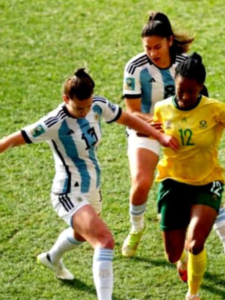[ez-toc]”Stay up to speed on breaking news from the 2024 Summer Olympics! Breaking (breakdancing) made a historic debut at the 2024 summer Olympics.”
However, breaking will not be featured in the 2028 Los Angeles Olympics, disappointing many fans and participants. Discover the reasoning for this choice and the new sports that will be added at the 2028 Games.
Learn about breaking’s path to the 2024 summer Olympics, its impact on the global dance community, and what the future holds for this unique sport.
Will breaking return at the 2032 Brisbane Olympics? Explore the full story to learn why breaking will not return to the 2028 Olympics and other sports will take its place in Los Angeles.
Don’t miss out on the most recent developments and insights from the dynamic world of 2024 summer Olympic sports.”
Introduction:-
Breaking, also known as breakdancing, has long been a cultural phenomenon, with its roots deep in 1970s street culture.
Over the years, it has grown from clandestine dance wars to a widely acknowledged art form, earning popularity as both a competitive sport and a colorful expression of creativity.
This surge in popularity resulted in a watershed event for the sport: its debut at the 2024 summer Olympics.
For the first time, breaking was featured on the world’s largest sporting stage, with B-boys and B-girls from all around the world exhibiting their ability, artistry, and athleticism.
The inclusion of breaking in the 2024 summer Olympics was hailed as a groundbreaking achievement, marking a significant milestone in the sport’s journey.
Fans and athletes alike celebrated this recognition of breaking as a 2024 summer Olympic sport, anticipating its future in upcoming Games.
However, the excitement was short-lived, as breaking was later excluded from the list of sports for the 2028 Los Angeles Olympics.
This surprising decision has sparked widespread curiosity and debate, leading to the central question: Why won’t breaking be featured in the 2028 Olympics, and what does this mean for the future of the sport?
1. Breaking’s Historic Debut at the 2024 summer Olympics
(a) The Origin of Breaking in 2024 summer olympics:-
Breaking, also known as breakdancing, evolved in the thriving street culture of 1970s New York, notably in the Bronx.
Breaking, which originated as a merger of music, dance, and community, quickly became a strong form of expression for disenfranchised adolescents, representing their hardships, hopes, and inventiveness on 2024 summer olympics.
It was more than simply a dance; it was a cultural movement that had a global impact on art, fashion, and entertainment.
What began as an underground street dance has grown into an internationally recognized sport, renowned for its complexity, athleticism, and creativity.
(b) Breaking’s Journey to the 2024 summer Olympics:-
The road from the streets to the Olympic stage was long and difficult.
The World DanceSport Federation (WDSF) worked to establish breaking as a genuine sport.
The WDSF was instrumental in campaigning for breaking’s inclusion in international events, portraying it as a sport that blends physical prowess with creative expression.
Breaking’s first big step toward Olympic recognition occurred when it was featured in the 2018 Youth Olympic Games in Buenos Aires.
This was a watershed moment for the sport, showcasing emerging breakers on a worldwide scale and paving the way for its eventual inclusion in the 2024 summer Olympics.
The inclusion of breaking in the Olympics reflected the sport’s growing popularity and cultural significance.
The WDSF’s relentless efforts, together with the backing of the breaking community, made it possible for breaking to be included in the 2024 Summer Games.
The International Olympic Committee’s (IOC) decision to include breaking in the Paris Olympics was viewed as a daring step, highlighting the Games’ shifting nature and its goal of connecting with younger audiences through urban sports.
(c) 2024 summer Olympics Debut
Breaking made its much anticipated premiere at the 2024 summer Olympics, captivating fans with its distinct blend of athleticism, creativity, and cultural legacy.
The competition structure was designed to highlight the sport’s best aspects, with fierce one-on-one clashes between competitors known as B-boys and B-girls.
The judges judged the performances using six main criteria: inventiveness, personality, technique, variety, performativity, and musicality.
These requirements ensured that athletes demonstrated not just their physical ability, but also their artistic flair and uniqueness.
2024 summer Olympic breaking competition featured remarkable moments that left an indelible impression on both the spectators and the sport’s history.
Raygun from Team Australia delivered excellent performances, despite receiving criticism, and quickly became a fan favorite for her distinct style and determination.
Victor Montalvo of Team USA also made news by winning the bronze medal, firmly establishing himself as one of the sport’s elite competitors.
Canada’s Phil Wizard won the gold medal, while France’s Dany Dann got silver, adding to the event’s enthusiasm and reputation.
Breaking’s Olympic debut was more than just a sport; it was a celebration of a cultural phenomenon that had finally made its way to the world’s greatest stage.
Breaking’s presence in the 2024 summer Olympics not only recognized its rich past, but also established a new benchmark for the sport, motivating a new generation of breakers and elevating the global perception of breaking as a genuine and respected activities.

yourstory.com
pexels.com/search/kayak
thestoryhome.com
google.com
pinterest.com
unsplash.com
flickr.com
pexels.com
for beautiful images/videos.
2. The Impact of Breaking at the 2024 summer Olympics:-
(a) Cultural Significance of 2024 summer olympics:-
The inclusion of breaking in the 2024 summer Olympics was a watershed moment, not just for the sport, but also for the portrayal of street culture on a worldwide scale.
For the first time, the raw, dynamic spirit of urban dance forms was displayed alongside traditional Olympic sports, introducing the art of breaking to a global audience who had never seen it before.
This was regarded as a significant cultural milestone, representing the acceptance and endorsement of a previously underground art form.
The global dance community, notably the breaking scene, reacted overwhelmingly positively.
For many breakers, this was a long-awaited recognition of their devotion, ability, and the cultural significance of their work.
The sense of validation that comes with being acknowledged on such a renowned platform instilled pride and delight among the breaking community, establishing breaking’s place in both sports and culture.
(b) Breaking Athletes on 2024 summer olympics:-
The 2024 summer Olympics exposed the world to some of breaking’s brightest stars, whose performances thrilled fans while simultaneously transforming them into global ambassadors for the sport.
Phil Wizard, the Canadian B-boy who won the gold medal, was lauded for his fluidity, technical ability, and originality.
His path to the Olympics was one of great preparation and determination, combining tough training with a strong connection to the origins of breaking.
Dany Dann of France, who won silver, was another outstanding athlete.
His precise and flair-filled technique struck a chord with both judges and onlookers.
Dann’s performance instilled national pride and cemented France’s reputation as a hotbed of emerging talent.
Raygun, who represented Team Australia, quickly gained popularity among fans, particularly on social media.
Despite criticism and underdog status, her determination and distinct style won over fans, establishing her as a role model for aspiring B-girls around the world.
Victor Montalvo of Team USA, who won the bronze medal, contributed significantly to the sport’s popularity. Montalvo, known for his explosive skills and charm, rose to prominence on social media, inspiring a generation of young dancers.
The media focused on the athletes’ profiles, histories, and 2024 summer Olympic preparations, drawing attention to both their personal tales and the larger story of breaking.
Quotes from these athletes reflecting on their Olympic experiences were widely distributed, strengthening their influence as role and.
(c) Audience Reception of 2024 summer olympics:-
The global response to breaking as an Olympic sport was largely enthusiastic.
The unusual concept of one-on-one combat, combined with the sport’s explosive nature, grabbed audiences all over the world.
Breaking’s premiere drew a large audience, with media outlets and social media platforms buzzing with opinions, highlights, and fan reactions.
During the event, breaking news hashtags trended, and video clips of significant moments were widely shared, raising the sport’s visibility even further.
In addition to media attention, breaking’s 2024 summer Olympics exposure sparked an increase in interest in breaking classes and contests worldwide.
Dance studios reported a surge in enrollment, particularly among younger demographics who were inspired by what they saw.
Competitions and breaking events witnessed increased participation and audience numbers, showing that the Olympic debut had a long-term impact.
This increased interest in breaking as both a sport and an art form demonstrates the 2024 summer Olympics enormous impact on the global dance community and the sport’s future.

yourstory.com
pexels.com/search/kayak
thestoryhome.com
google.com
pinterest.com
unsplash.com
flickr.com
pexels.com
for beautiful images/videos.
3. The Decision to Exclude Breaking from the 2028 Olympics:-
(a) Initial Announcement for 2024 summer olympics:-
In 2022, the International Olympic Committee (IOC) made the surprising decision to exclude breaking from the 2028 Olympics, which are set to be hosted in Los Angeles.
This announcement came as a shock to many, especially given the sport’s successful debut at the 2024 Paris Games.
Breaking had captured the attention of a global audience, introducing a new wave of excitement and cultural significance to the 2024 summer Olympics platform.
However, despite its positive reception, the Los Angeles organizing committee, in collaboration with the IOC, decided to move forward with other sports, excluding breaking from their lineup.
A variety of factors contributed to the decision.
When selecting sports for the Games, the Los Angeles 2028 organizing team had to consider a variety of criteria.
Considerations included global popularity, youth participation, logistical viability, and the event’s overall goal.
While it excelled in young participation and cultural effect, it may not have met the organizers’ objectives, which included introducing new and upcoming sports while keeping the 2024 summer Olympics’ traditional essence.
(b). Reactions to the Exclusion of 2024 summer olympics:-
The decision to exclude breaking from the 2028 Olympics was met with widespread disappointment, particularly within the breaking community and its governing body, the World DanceSport Federation (WDSF).
Prominent figures in the breaking scene, including athletes who had participated in the 2024 Games, expressed their frustration and sadness over the exclusion.
The WDSF released statements highlighting the significant strides breaking had made in gaining global recognition and the potential for continued growth, which they believed would have been further bolstered by another Olympic appearance.
Breaking’s absence from the Los Angeles Olympics is ironic given its extensive origins in American culture, specifically in the streets of New York City in the 1970s.
The sport’s rise from a grassroots movement to a globally recognized tournament appeared to fit well with the culture of Los Angeles, a city noted for its broad cultural heritage and artistic expression.
Despite this cultural connection, breaking was overlooked, generating controversy about the criteria used to evaluate Olympic sports and the potential wasted opportunity to honor an American-born sport on home turf.
(c). Comparative Analysis of 2024 summer olympics:-
Breaking’s absence from the 2028 Olympics was not an exceptional instance.
The history of the 2024 summer Olympics Games is replete with examples of sports that were included and then removed depending on a variety of criteria.
For example, baseball and softball were withdrawn from the 2024 summer Olympics schedule following the 2008 Beijing Games, only to be returned for the 2020 Tokyo Games due to popular demand, particularly in Japan.
Similarly, sports with large global followings, such as karate and squash, have failed to achieve a permanent presence in the Olympics.
The elements that influence a sport’s inclusion or exclusion are intricate and numerous.
Youth participation is crucial, since the IOC hopes to bring younger viewers to the Games.
Breaking had a tremendous appeal in this area, particularly among younger generations due to its lively and expressive nature.
Cultural significance also plays a role, with sports that reflect the host country’s identity frequently preferred.
In this context, the absence of breaking from the Los Angeles Games is especially perplexing.
Global popularity is another important consideration, since the IOC strives to include sports with a large international following.
While breaking has seen a boom in global attention, particularly following its Olympic debut, it may not have attracted the same level of broad involvement as other established sports.
Furthermore, logistical issues, such as the cost of putting up venues and the difficulty of judging, might have an impact on sport inclusion.
Finally, the decision to eliminate breaking from the 2028 Olympics emphasizes the hurdles that growing sports have in keeping its position on the Olympic scene.
Despite its cultural relevance and attraction to younger audiences, breaking was eventually ruled out, raising concerns about the future of niche sports in the Olympics and the criteria used to select their value.
4. What’s Taking Breaking’s Place in the 2028 Olympics?
(a). New Sports in the 2028 Olympics
As breaking steps aside for the 2028 Olympics in Los Angeles, the focus shifts to numerous new and returning sports that will take their place.
Men’s and women’s flag football will be included at the 2028 Games, as will squash, a long-awaited addition that has been striving for Olympic status for years.
Furthermore, sports like baseball and softball, which were originally part of the Olympics but were eliminated, are making a comeback, much to the delight of their worldwide fan bases.
Lacrosse and cricket are also likely to return, adding to the variety of sports on offer.
The 2028 Los Angeles Games’ ambition of combining traditional and developing sports is reflected in the selection of these sports to appeal to a broad audience.
Flag football, for example, capitalizes on the immense popularity of American football, notably in the United States, by providing an accessible, less contact-intensive version of the game that can captivate both participants and fans globally.
Squash’s inclusion is viewed as a success for a sport that has long been popular in many nations but has struggled to obtain Olympic recognition until now.
The resurgence of baseball and softball is especially noteworthy considering their close ties to American culture.
Their reinstatement is consistent with the host city’s goal of celebrating sports that have a strong appeal to both local and national audiences.
Similarly, the addition of cricket, a sport with a large following in places like South Asia, the United Kingdom, and Australia, speaks to global aspirations the Olympics aims to draw viewers from all across the world.
Lacrosse, which originated in Native American tradition, provides another layer of historical and cultural value to the 2028 Games.
(b). Impact on Breaking Community in 2024 summer olympics:-
Breaking’s removal from the 2028 Olympics has surely created a gap in the breaking world, especially in the United States, where the sport originated.
The disappointment is apparent, especially given the sport’s stunning premiere in Paris 2024, which was regarded as a watershed moment in introducing street culture to the international scene.
The omission might stifle the momentum that breaking earned from its 2024 summer Olympic presence, potentially harming the sport’s growth and awareness, particularly among younger audiences enthused by its involvement in the 2024 summer Olympics.
However, while the setback is substantial, it also provides fresh options for the breaking community.
International tournaments such as the World Breaking Championship, as well as regional events, may see an increase in participation and viewership as the community comes together to keep the sport in the spotlight.
Furthermore, breaking may make its way back into future Olympic Games, especially if the community continues to fight for its inclusion and displays its cultural and athletic significance on the international scale.
In the United States, where breaking has deep cultural roots, the emphasis may move to developing the next generation of breakers via grassroots efforts, local competitions, and increasing media coverage.
Breaking has the potential to acquire popularity in other multi-sport events such as the X Games or World Games, where its dynamic and expressive nature will appeal to fans.
In conclusion, while breaking’s absence from the 2028 Olympics is disappointing for the community, the addition of other sports such as flag football, squash, baseball, and cricket demonstrates the Games’ expanding nature.
The breaking community now faces the difficulty of preserving the sport’s momentum outside the Olympic structure; nevertheless, with sustained support and lobbying, breaking may continue to grow and perhaps even restore its place in future Olympic Gam

yourstory.com
pexels.com/search/kayak
thestoryhome.com
google.com
pinterest.com
unsplash.com
flickr.com
pexels.com
for beautiful images/videos.
5. The Future of Breaking in Global Sports of 2024 summer olympics:-
(a). Prospects for 2032 Brisbane Olympics:-
The absence of breaking from the 2028 Los Angeles Olympics has aroused much controversy, but it does not necessarily mean the end of its Olympic career.
As we look ahead to the 2032 Brisbane Olympics, there is rising speculation that breaking may make a comeback.
The World DanceSport Federation (WDSF) is already planning strategies to keep breaking in the Olympic spotlight.
They will most certainly continue to highlight the sport’s worldwide popularity, youth participation, and distinct cultural relevance in order to position it as a strong contender for future inclusion.
The campaign for breaking’s comeback is further bolstered by its favorable response at the 2024 Paris Olympics, when it drew the attention of a broad and young audience.
Stakeholders in the breaking community work relentlessly to maintain the sport relevant and prominent on the global scale.
Advocacy activities, combined with strong grassroots support, could persuade the International Olympic Committee (IOC) to rethink breaking for the 2032 Games, particularly if the sport continues to develop in participation and viewership.
With the 2032 Olympics still several years away, the breaking community has plenty of opportunity to make a strong argument for its re-inclusion.
(b). Breaking’s Evolution: Beyond the 2024 summer Olympics:-
Even if breaking does not earn a position in future Olympic Games, its development as a worldwide sport is far from ended.
The publicity surrounding its 2024 summer Olympic debut has already prepared the path for breaking to spread beyond the Olympic framework.
We may see the birth of new international championships dedicated solely to breaking, which might match other big dance or athletic events in popularity.
These competitions might draw substantial corporate deals, media attention, and a devoted worldwide fan base, all of which would help the sport’s growth and credibility.
The media landscape is also changing in a way that may favor breaking.
Digital platforms and social media provide unmatched opportunity to showcase breakout performances, create viral moments, and interact with a worldwide audience.
This internet presence could help to sustain breaking’s momentum, allowing the sport to achieve new heights while being culturally important even outside of the Olympic Games.
(c). Community Initiatives and Youth Engagement in 2024 summer olympics:-
One of the most promising aspects of breaking’s future is the endeavor to engage the next generation of breakers.
Programs aimed at introducing young people to the sport are growing around the world, with several gaining traction following breaking’s 2024 summer Olympics debut.
These programs aim not only to educate the dance, but also to convey the cultural and historical value of breaking, ensuring that the sport’s rich past is preserved as it evolves.
Youth engagement is very important for the long-term viability of breaking.
The Olympics’ popularity has inspired countless young dancers to take up the sport, and this trend is expected to continue as additional programs become available.
Schools, community organizations, and dance studios are increasingly offering breaking workshops, and competitions geared toward younger audiences are gaining popularity.
This grassroots growth is critical to ensuring that breaking remains vital and relevant, as it fosters a new generation of athletes who may one day take the sport to even higher heights.
In conclusion, while breaking’s omission from the 2028 Olympics is disappointing, the future seems promising.
The chances of its comeback in 2032 are good, especially with continuous campaigning and strategic initiatives by the WDSF and the worldwide breaking community.
Beyond the Olympics, breaking is ready to expand as a sport with additional events, increased media exposure, and powerful community efforts to inspire and involve the next generation of dancers.
6. Reflecting on Breaking’s 2024 summer Olympics Journey:-
(a). Successes and Challenges of 2024 summer olympics:-
Breaking’s trip to the Olympics is an incredible accomplishment in the realm of sports.
What started as an underground street dance in the 1970s has grown into a widely recognized and respected discipline, with its debut at the 2024 summer Olympics.
This historic occasion was a major success for the breaking community, emphasizing the sport’s cultural significance, artistic expression, and athleticism.
The inclusion of breaking in the Olympics drew considerable exposure to the sport, bringing it to a new audience and confirming the efforts of breakers who have long argued for its legitimacy as a competitive discipline.
However, the path to Olympic recognition was not without hurdles.
The process of achieving inclusion took years of agitation, negotiation, and demonstrating breaking’s global popularity and importance.
The World DanceSport Federation (WDSF) was instrumental in this effort, working relentlessly to highlight breaking’s distinct characteristics and match it with the objectives of the 2024 summer Olympics movement.
The sport’s inclusion in the Youth Olympic Games in Buenos Aires in 2018 was a key step toward its eventual presence on the Olympic stage.
Looking ahead, breaking will face the difficulty of sustaining its momentum and awareness in the global sports arena, particularly following its removal from the 2028 Los Angeles Olympics.
To remain relevant, the sport must continue to evolve and adapt, building on its Olympic debut triumphs while addressing the reasons that contributed to its elimination.
This involves increasing its global visibility, encouraging youth participation, and looking into new chances for competition and publicity outside of the 2024 summer Olympics framework.
The breaking community’s tenacity and inventiveness will be critical in managing these hurdles and assuring the sport’s ongoing growth and recognition.
(b). What Breaking’s Olympic Story Teaches Us About Sports Inclusion:-
Breaking’s Olympic journey provides unique insights into the intricate process of sports inclusion at the Olympic Games.
The sport’s journey to the 2024 summer Olympics demonstrates the significance of cultural relevance, youth engagement, and global appeal in the selection process.
Breaking’s inclusion reflected the Olympic movement’s shifting goals, notably its emphasis on drawing younger audiences and adopting sports that are relevant to modern society.
At the same time, breaking’s absence from the 2028 Los Angeles 2024 summer Olympics highlights the problems that new sports confront in keeping their position on the 2024 summer Olympic program.
The decision to remove breaking was influenced by a number of factors, including the host city’s preferences, the overall vision for the Games, and competition from other sports seeking inclusion.
This result exemplifies the fluid and dynamic nature of sports inclusion, where even a sport as alive and culturally significant as breaking must constantly demonstrate its worth to remain on the 2024 summer Olympics program.
Breaking’s past serves as both a cautionary tale and an inspiration to other fledgling sports seeking 2024 summer Olympics accreditation.
It indicates that, while obtaining a footing in the 2024 summer Olympics is an impressive feat, maintaining that place necessitates continual effort, campaigning, and adaptability.
For other sports aspiring to 2024 summer Olympics inclusion, breaking’s journey emphasizes the necessity of integrating with the Olympic movement’s bigger ideals, creating a strong global community, and demonstrating the sport’s distinctive worth on a global scale.
In conclusion, Breaking’s 2024 summer Olympics career has been filled with both accomplishments and tribulations.
Its selection in the 2024 summer Olympics was a historic achievement, but the sport now must maintain its momentum and relevancy in a competitive and ever-changing landscape.
Breaking’s narrative provides valuable lessons for other new sports, providing light on the intricacies of 2024 summer Olympics inclusion and the continual work required to acquire and sustain recognition at the highest level of world sport.

yourstory.com
pexels.com/search/kayak
thestoryhome.com
google.com
pinterest.com
unsplash.com
flickr.com
pexels.com
for beautiful images/videos.
Conclusion
Breaking’s inclusion in the 2024 summer Olympics was a watershed moment not only for the sport, but also for the worldwide athletic landscape.
It was a stunning acknowledgement of the cultural significance of breaking, a dance form that began on the streets of New York and developed into a global phenomenon.
The sport’s 2024 summer Olympics debut presented an opportunity for breaking to demonstrate its distinct blend of athleticism, inventiveness, and cultural expression on a worldwide scale.
It was a moment of affirmation for the breaking community, confirming the sport’s place among more established 2024 summer Olympics disciplines.
However, the surprise decision to eliminate breaking from the 2028 Los Angeles Olympics has raised concerns in the community about the criterion for sports admission and the significance of cultural representation in the 2024 summer Olympics Games.
This absence serves as a reminder of the difficulties that new sports face in establishing their place in the ever-changing 2024 summer Olympics schedule.
Despite this setback, the significance of ethnic diversity and representation in global sporting events should not be underestimated.
Breaking’s route to the 2024 summer Olympics emphasizes the need of including sports that appeal to younger viewers and reflect a diverse range of global cultures.
Looking ahead, there is optimism that breaking may return to the 2024 summer Olympics Games, possibly in 2032 or later.
The sport’s tenacity and the passion of its people indicate that breaking’s tale is far from over.
With continued efforts from the World DanceSport Federation and the worldwide breaking community, there is a good chance that breaking will continue to grow and expand, possibly earning another chance to shine on 2024 summer Olympics stage in the future.
Frequently Asked Questions
1. What is breaking, and how did it become 2024 summer Olympic event?
Breaking, also known as breakdancing, began in the 1970s as part of New York City’s street culture.
It progressed from a dancing style to a recognized competitive sport, earning worldwide recognition.
Its path to the Olympics began with its inclusion in the Youth Olympic Games in 2018, and it was formally accepted as an Olympic sport for the 2024 summer olympic Games.
2. Why was breaking incorporated into the 2024 summer Olympics?
Breaking was added to the 2024 summer Olympics as part of the International Olympic Committee’s (IOC) goal to attract younger audiences and incorporate more varied, culturally meaningful sports into the Games.
The World DanceSport Federation (WDSF) was instrumental in promoting breaking’s inclusion.
3. Why won’t breaking be included in the 2028 Los Angeles Olympics?
The Los Angeles organizing committee and the IOC jointly decided to exclude breaking from the 2028 Los Angeles Olympics.
They made their decision based on a variety of reasons, including the selection of sports that were consistent with their vision for the Games.
The exact criteria for removal have not been revealed, however it is thought that variables such as global popularity, audience engagement, and practical considerations played a role.
4. What sports will be added to the 2028 Los Angeles Olympics rather than eliminated?
The 2028 Los Angeles Olympics will include new sports such as men’s and women’s flag football, squash, as well as the return of baseball, softball, lacrosse, and cricket.
These sports were chosen for their broad appeal and alignment with the vision of the 2028 Games.
5. How did the breaking community respond to their rejection from the 2028 Olympics?
The breaking community expressed anger and frustration at their omission.
Many believed that breaking’s cultural significance, particularly in the United States, made it an excellent candidate for inclusion in the Los Angeles 2024 summer Olympics.
The decision was interpreted as a loss to the sport’s prominence on the global stage.
6. Is it possible that breaking may return to the 2024 summer Olympics in the future?
Yes, breaking may return to the 2024 summer Olympics in the future, possibly during the 2032 Brisbane Olympics.
The World DanceSport Federation and other stakeholders are working hard to keep dancesport in the 2024 summer Olympic spotlight and advocating for its participation in future Games.
7. How did breaking’s inclusion in the 2024 summer
Olympics affect the sport?
Breaking’s inclusion in the 2024 summer Olympics has considerably increased the sport’s global awareness and legitimacy.
It exposed street culture to a global audience, inspired a new generation of dancers, and raised the profile of top competitors in the sport.
The exposure also sparked an increased interest in breaking competitions and classes.
8. How can breaking develop as a sport without 2024 summer Olympic inclusion?
Breaking can expand through further international tournaments, increased media coverage, and sponsorships.
The community is also concentrating on youth engagement and grassroots activities to ensure the sport’s long-term evolution and appeal, regardless of 2024 summer Olympic classification.



